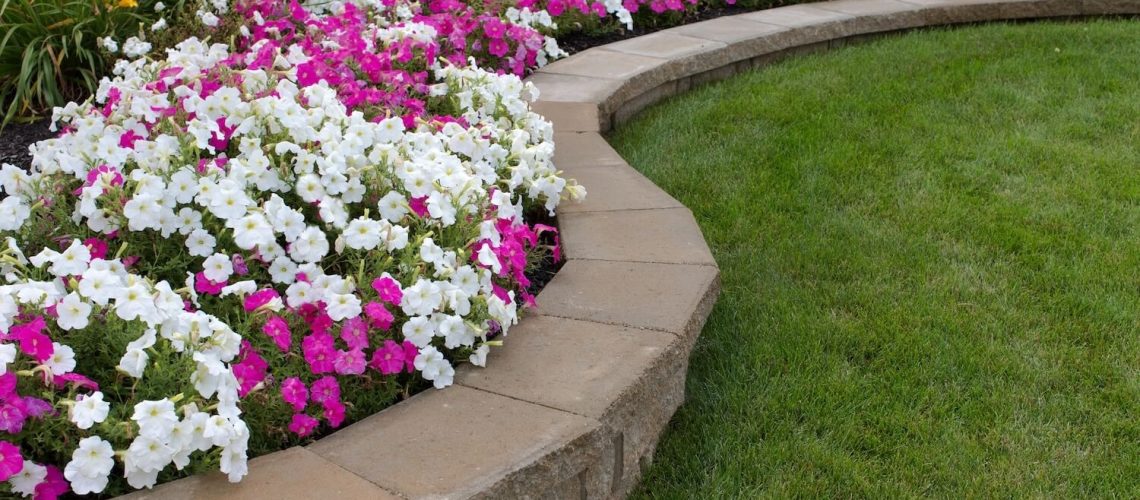Gardening is more than just a hobby; it’s an art form that allows you to transform your outdoor space into a personal paradise. One of the most effective ways to elevate the aesthetic appeal and functionality of your garden is by using paver borders. These versatile and stylish elements can frame your garden beds, define walkways, and create a cohesive look throughout your landscape. In this article, we’ll explore the benefits of using paver borders, considerations for choosing the right materials, the importance of professional installation, creative ideas to enhance the beauty of your garden, and maintenance tips to keep your paver borders looking pristine.
The Benefits of Paver Borders in Gardens
Paver borders offer several advantages that go beyond mere aesthetics. Here are some key benefits:
Visual Appeal and Design Flexibility
Paver borders add a polished and structured look to any garden. They come in various shapes, colors, and materials, allowing you to match or contrast them with existing landscape features. Whether you’re aiming for a classic, rustic, or modern look, pavers provide the flexibility to achieve your desired design vision.
Defining Spaces
Paver borders are excellent for delineating different areas within your garden. They can separate flower beds from lawns, create distinct pathways, or highlight specific garden features. This clear definition not only enhances the visual appeal but also helps in managing different plant zones and maintenance routines.
Preventing Soil Erosion and Weed Spread
Paver borders serve as a barrier that prevents soil erosion, especially on sloped terrains. They also help in containing mulch, stones, or other garden materials, reducing the likelihood of weeds spreading into unwanted areas.
Paver Durability and Low Maintenance
Unlike wooden or plastic borders, pavers are incredibly durable and weather-resistant. They require minimal maintenance, often needing just an occasional rinse or sweep to keep them looking fresh.
Enhanced Property Value
A well-designed garden with professional-looking paver borders can significantly boost your property’s curb appeal and overall value. It’s an investment that not only beautifies your home but also offers potential financial returns.
Considerations for Choosing Paver Borders
When choosing paver borders for your garden, consider the following factors to ensure they complement your overall landscape design:
- Material and Color The material and color of the pavers should harmonize with your home’s exterior, existing garden elements, and personal style preferences. Common materials include concrete, brick, and natural stone, each offering different aesthetics and durability levels. For example, concrete pavers can be molded to mimic stone or brick, providing versatility, while natural stone pavers offer a unique, organic appearance.
- Size and Shape The size and shape of the pavers can influence the overall look of your garden. Larger pavers create a more modern, streamlined appearance, while smaller ones can add intricate details. The shape can also vary from rectangular and square to more irregular forms, allowing for creative design patterns. Circular or curved pavers can soften the edges and create a more inviting and natural flow.
- Pattern and Layout Consider the pattern and layout of the pavers to achieve the desired visual effect. Options like straight lines, curves, and interlocking designs can create different moods and styles. For example, a herringbone pattern offers a dynamic and sophisticated look, while a simple linear layout provides a clean and minimalist aesthetic. The choice of pattern can also impact the perceived space and movement within your garden.
- Climate and Environment The local climate and environment play a crucial role in selecting the right paver material. For instance, areas with freeze-thaw cycles require pavers that can withstand temperature fluctuations without cracking. Likewise, regions with heavy rainfall might benefit from permeable pavers that aid in drainage. It’s also important to consider the paver’s resistance to fading and staining, particularly in areas with intense sunlight or exposure to organic matter.
- Sustainability and Eco-Friendliness For environmentally-conscious homeowners, considering the sustainability of paver materials is essential. Look for pavers made from recycled materials or those produced through environmentally-friendly processes. Permeable pavers are also a great choice as they allow water to seep through, reducing runoff and promoting groundwater recharge.
The Importance of Professional Installation
While DIY projects can be satisfying, installing paver borders often requires a level of expertise to ensure longevity and functionality. Here’s why hiring professionals is beneficial:
Expertise and Precision
Professional paver installers have the skills and experience to execute precise cuts, level the ground accurately, and ensure a stable foundation. This precision is critical in preventing future issues such as uneven settling, shifting, or water drainage problems. Their expertise also ensures that the pavers are laid in a way that enhances both aesthetics and functionality.
Proper Tools and Materials
Professionals have access to specialized tools and high-quality materials that may not be readily available to DIY enthusiasts. This access ensures that the installation is not only efficient but also meets industry standards for durability and appearance. From compactors to specialized cutting tools, the right equipment can make a significant difference in the quality of the installation.
Time and Cost Efficiency
While it may seem cost-effective to install pavers yourself, the potential for mistakes can lead to additional costs in repairs or replacements. Professionals can complete the project more quickly and correctly the first time, potentially saving you money and hassle in the long run. Moreover, professional services often include warranties or guarantees, offering peace of mind.
Design Consultation
Many professional landscaping companies offer design consultation services, helping you choose the best paver style, layout, and materials for your specific garden needs. This guidance can be invaluable in achieving a cohesive and aesthetically pleasing result. They can also offer insights into the latest trends and innovations in landscaping.
Warranty and Support
Professional installations often come with warranties, providing peace of mind in case of future issues. Additionally, you can benefit from ongoing support and maintenance services, ensuring your paver borders remain in excellent condition. This support can include regular check-ups, cleaning, and resealing services.
Creative Ideas for Paver Borders
Beyond the basic installation, there are creative ways to use paver borders to add unique elements to your garden:
- Patterned Edging Experiment with different laying patterns such as zigzag, chevron, or alternating colors to create a striking border design. These patterns can add a layer of sophistication and interest to your garden. Custom patterns can also reflect your personal style or complement architectural elements in your home.
- Mixed Materials Combine pavers with other materials like gravel, pebbles, or mulch to create a textural contrast and visual interest. This approach can also help integrate the paver borders with other landscape features. For example, using natural stone pavers with gravel infill can create a rustic and organic look.
- Lighting Integration Install low-voltage lighting along the paver borders to illuminate pathways and garden features, adding both safety and ambiance. Lighting can highlight the beauty of your garden at night and create a welcoming atmosphere. Consider using solar-powered lights for an eco-friendly option.
- Raised Borders Create raised garden beds with paver borders to add height and dimension to your garden. This is especially useful for showcasing specific plants or creating a focal point. Raised borders can also make gardening more accessible and reduce the strain of bending over. They can also help with soil drainage and prevent soil compaction.
- Water Features Use paver borders to outline water features like ponds or fountains, adding a touch of elegance and structure. The borders can help contain water and plant life, creating a serene and organized water garden. Consider using natural stone pavers for a harmonious and organic look.
- Seating Areas Extend the functionality of paver borders by incorporating them into seating areas or patios. This creates a seamless transition between different parts of your garden and provides a comfortable space for relaxation and socializing.
- Thematic Gardens Use paver borders to define thematic garden areas, such as herb gardens, flower beds, or vegetable plots. This not only adds visual interest but also helps in organizing and maintaining different plant types.
Maintaining Your Paver Borders
Paver borders are low-maintenance, but regular upkeep can prolong their life and keep them looking pristine. Here are some maintenance tips:
- Cleaning: Sweep the pavers regularly to remove dirt and debris. For deeper cleaning, use a mild detergent and water. Avoid harsh chemicals that could damage the paver material. A power washer can be used for thorough cleaning, but it’s important to use the appropriate pressure setting to avoid damaging the pavers.
- Weed Control: Occasionally, weeds may grow in the joints between pavers. Pull them out by hand or use a weed killer. Polymeric sand can also help prevent weed growth by hardening in the joints and blocking weed seeds from taking root.
- Resanding Joints: Over time, the sand in the joints may wash away. Reapply sand as needed to keep the pavers stable and prevent weed growth. Polymeric sand is especially effective as it hardens upon contact with water, providing additional stability and weed prevention.
- Repairs: If a paver becomes damaged or loose, it’s relatively easy to replace. Simply remove the damaged paver, adjust the base if necessary, and replace it with a new one. It’s advisable to keep some extra pavers from the original installation for any future repairs.
- Sealing: Depending on the type of pavers and the climate, resealing may be necessary every few years to protect the pavers from stains, weathering, and fading. Sealing enhances the color of the pavers and provides a protective layer against moisture and UV rays.
- Pest Control: While not common, ants or other pests may sometimes nest under paver borders. Regular inspections and appropriate pest control measures can prevent any potential issues.
Conclusion
Paver borders are a versatile and attractive solution for enhancing your garden’s aesthetics and functionality. By choosing the right materials, considering professional installation, and exploring creative design options, you can transform your garden into a beautifully framed oasis. Investing in paver borders is not just about creating a neat and organized garden—it’s about crafting a space that reflects your personal style and enhances the overall outdoor experience.
With proper installation and maintenance, paver borders can provide long-lasting beauty and function, turning your garden into a space you’ll enjoy for years to come. Whether you’re looking to add curb appeal, increase property value, or simply create a more enjoyable outdoor environment, paver borders are a smart and stylish choice. Embrace the elegance and versatility of paver borders, and watch as your garden transforms into a stunning landscape masterpiece.

